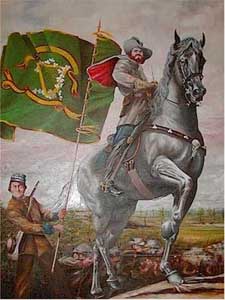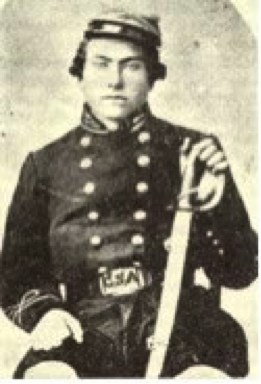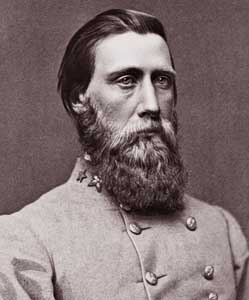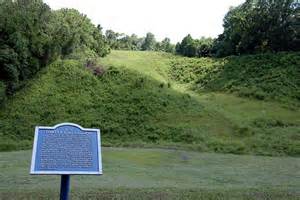Rivers Run South

(In the painting, God’s Own Gentleman, Patrick Griffin is shown with his commander, Colonel Randal McGavock, holding the “Sons of Erin” flag during the Battle of Raymond. Courtesy of Jerry McWilliams, SouthernCedarsGallery.com).
There is a reason I am going back through the files- I will get to that, presently, but I am looking for the address in Nashville, and the places on the field at Vicksburg, and some other incidentals about the war my kin fought in the West.
I have been interested for years in a short paragraph in the family genealogy that mentioned great-great uncle Patrick having participated in “twenty four general engagements” in the late unpleasantness between the States, and being “Selected as Headquarters scout for General John Bell Hood.”
There also was a note about his dear Colonel’s name being passed down in the family. Patrick told quite a florid account of the death of Randal McGavock at the Battle of Raymond in Mississippi. The Colonel was a graduate of the Harvard Law School and former Mayor of Nashville. He had done quite well for an Irishman, and Patrick called him “God’s Own Gentleman.”
Patrick’s daughter Louisa McGavock Griffin was christened in honor of the Colonel’s mother.
I had a chance to review Patrick’s service record at the National Archives a few years ago, and his story appears based on fact, regardless of the filigree that grew around it as the years went by. The story of his interaction with Colonel McGavock’s body at Raymond is there, in the spidery handwriting and brown ink of the time. If the story got better with time, that is only to be expected.
Patrick Martin Griffin was born in County Galway, Ireland, in 1844. He came to America with his parents, Michael and Honora, when he was three, around 1847. The family had an arduous thirteen- week passage on the sailing ship David. Landing in Baltimore, Mike looked for work. He found it in Alexandria, not far from my residence at Big Pink The Griffins arrived in Alexandria, VA, shortly thereafter a couple miles from where I live now in 1849. He was employed in swinging a hammer and laying down track for the Orange and Alexandria, the B&O and L&N Railroads.
They moved south and west shortly thereafter, first down through Culpeper to Gordonsville, then west to Cedar Hill near Nashville. They were preparing to return to Ireland to reunite with the children they had left behind, including their daughter Barbara, when Mike died suddenly of sunstroke.
Honora married again, and never returned to Ireland. In her later years, she lived with her daughter Barbara for a time after she emigrated from the Auld Sod, and with Patrick. But that is part of the world that came after the war.

(Great Great Uncle Patrick, in one of his uniforms. He had several.)
The biographical information about the clan is in a thick binder. The information on Patrick said to have been copied from “An Authentic Biographical Sketch of Company B- Confederate Veterans of Nashville” published in 1902. Not everything is on the net, not yet, anyway, but this is what the notes say:
“Corporal Patrick M. Griffin was born in Galway, Ireland, Sunday, March 17th, 1844.”
Born on St. Patrick’s Day, or close enough! Could there be a greater gift of the blarney bestowed on any child?
Patrick joined the “Sons of Erin” at Nashville in April of 1861, the month of Fort Sumpter. This company later became Company H of the 10th Tennessee Irish. After being captured in the Fort Donelson campaign and interned in Chicago, he was paroled and rejoined the reorganized 10th Tennessee to command his old Company H in the Georgia campaign.

(John Bell Hood, late of Texas).
He was wounded twice, and was one of three surviving members of the company after the battle of Peachtree Creek. After the fall of Atlanta, he was detailed to General Hood’s Headquarters Scouts. In sum, he was captured three times, after Ft. Donelson, after the slaughter at Raymond, and at the end of the war when Hood turned himself in. Exchanged, escaped, and Paroled were how he accounted his returns. Along the way, he participated in twenty-four general engagements.
Patrick’s sister Barbara came from Ireland , where she had grown while living with kin who owned a small hotel in Clifden, Ireland. She came to Nashville and apparently had quite the gift of gab herself. My great-great grandfather, James Foley, was from Ireland himself, being born in County Kerry in 1840. His Union Army enlistment papers in January 1862 say that he was twenty, of “fair complexion, blonde hair, hazel eyes and six feet tall.”
He signed up at Cincinnati for three years with Company K of the 72nd Ohio Volunteer Infantry (OVI). James was a regimental teamster at one point, and the unit had service at Shiloh, the Siege of Corinth, Vicksburg and Jackson. At Vicksburg, his unit was in combat near a place now called “Thayer’s Approach.”

(Thayer’s Approach, Vicksburg, TN.)
His three years were up in January of 1864, but the War Department was eager to retained seasoned troops. James was immediately re-enlisted under the provisions of the special orders of the Department as a “veteran volunteer.” He was owed a 30-day furlough and a $50 down payment on his $400 bounty in exchange for continued service.
I have held the certificate in my hands, and it is an impressive steel-etched thing.
The interesting thing is that James departed the unit on leave and never returned. The records of the 72nd OVI show him “deserted on veterans furlough in Cincinnati.” What is more interesting is that he married Barbara, Patrick’s sister, that very year.
We have no one alive who can tell us how the sister of the Confederate officer hooked up with the tall young teamster, but hook up they did, and were married in the war year of 1864.
After the war, Patrick Griffin returned to Nashville and married Bridget Welch, with whom he had six children, three of whom survived infancy. Bridget died sometime after 1880, and he re-married Annie Dean Breene, and had another two children. He built his own house, and was Superintendent of the Planing Mill for the Nashville, Chattanooga & St. Louis RR for 52 years. he died at the age of 77, on June 5th, 1921.
Louisa McGavock Griffin remained single all her life, living in the house that Patrick built at 300 12th Avenue South, Nashville for fifty-one years. She left the dwelling in 1951 to live with her sister Blanche Griffin Martin in Tylertown, Mississippi, until her death.
Former Yankee James Foley returned to the Irish settlement with his bride Barbara to Steubenville, Ohio, and a newspaper account has him owning The Tavern Store in Flushing in 1877.
He left this world two years after his beloved, Barbara in 1922, and they are both resting there still, in the rich soil that has been deposited by the Ohio River, as it rolls down to the Mississippi, past Vicksburg, and on to the warm waters of the Gulf.
Copyright 2015 Vic Socotra
www.vicsocotra.com
Twitter: @jayare303
